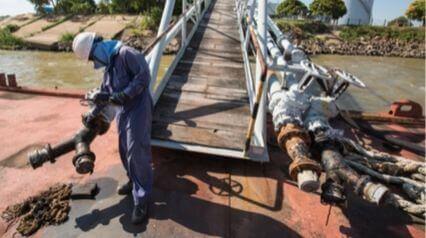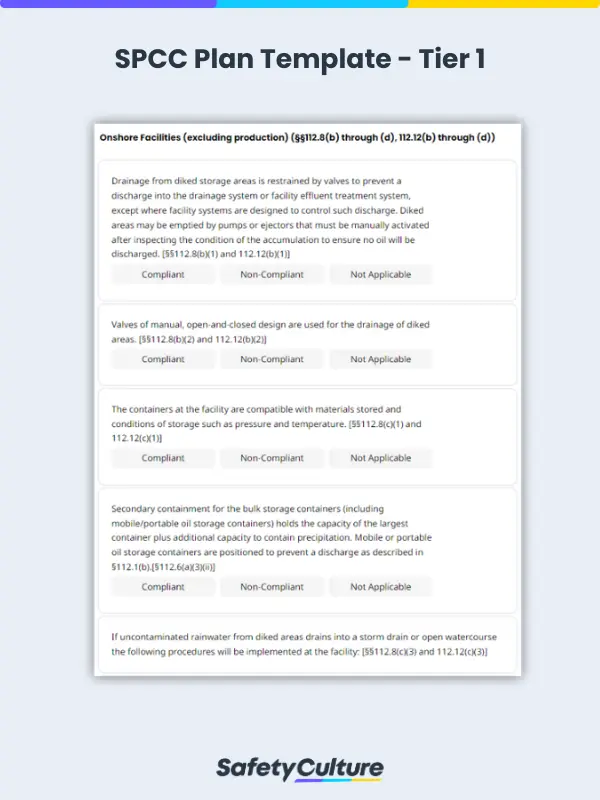What is an SPCC Plan?
An SPCC plan, or spill prevention plan, is the required documentation for the prevention and mitigation of oil spills in navigable waters or shorelines. SPCC means Spill Prevention, Control, and Countermeasure—a regulation that is part of the U.S. federal law, also known as Rule 40 CFR 112.
What is the Purpose of the SPCC Plan?
According to the U.S. Environmental Protection Agency (EPA), the purpose of an SPCC plan is to help prevent oil spills and control a spill should one occur. SPCC rules require the implementation of certified SPCC plans by owners or operators of qualified facilities containing storage for petroleum and oil products. An SPCC plan can also be self-certified upon following specific requirements.
What is an SPCC Plan Template?
An SPCC plan template is a guidance tool used to develop a spill prevention, control, and countermeasure plan that addresses the necessary SPCC rule requirements. SPCC plan templates can be completed electronically and customized accordingly to meet facility-specific needs. Using mobile-ready spill prevention plan templates can help owners and operators to not only create an SPCC plan, but also implement it in compliance with regulations.
What is an SPCC Plan Checklist?
An SPCC plan checklist, or spill response plan checklist, is a supporting attachment to an SPCC plan. For example, this SPCC plan checklist based on USEPA SPCC Guidance for Regional Inspectors features the following items for onshore oil drilling, production, and workover facilities:
-
- Dikes, berms, or retaining walls sufficiently impervious to contain oil,
- Curbing or drip pans,
- Sumps and collection systems,
- Culverting, gutters or other drainage systems,
- Weirs, booms or other barriers,
- Spill diversion ponds,
- Retention ponds, or
- Sorbent materials.
The SPCC plan checklist referred to above is for tier 2 qualified facilities and can also be used as a template for the primary SPCC plan. For tier 1 qualified facilities, this SPCC plan checklist can help owners or operators develop and implement criteria for state, local, and regional oil removal contingency plans.
What is the Goal of the Spill Prevention Countermeasures and Control Plan?
The U.S. EPA states that the SPCC plan must be maintained at the location of the facility that is normally attended at least four hours per day. Regardless of the tier, SPCC plans aim to provide procedures that can help qualified facilities achieve these 3 goals in compliance with SPCC rules:
SPCC Goal #1. Prevent oil spills
Personnel in the facility should be trained on the proper handling of oil and the correct use of equipment in order to prevent oil discharge. Aboveground storage tanks and equipment should be periodically inspected using the corresponding checklist to ensure that they are in good working condition to handle oil and oil products.
SPCC Goal #2. Prevent a spill from reaching navigable waters
The facility should be able to prevent a discharge from reaching nearby water through equipment or structures such as dikes, retention ponds, booms, or an equivalent containment system that can hold oil in the event of a spill. Proactively inspect equipment and structures to ensure that they are able to prevent spills from reaching navigable waters and that immediate action is taken if a spill is found.
SPCC Goal #3. Mitigating the effects of a spill in navigable waters
The facility’s communication system should be able to immediately notify the national response center (1-800-424-8802 or 1-202-426-2675) and other parties such as cleanup contractors in the event of a spill reaching nearby water. Use an oil containment checklist to make sure procedure is followed for the containment and cleanup of an oil spill.
Facilities that move or store gallons of oil aboveground are required to develop, maintain, and implement an SPCC plan. Determining a facility’s qualification and SPCC tier depends on its history of oil spills to navigable waters for the past 3 years and its aboveground oil storage capacity.
A Tier 1 facility has a total aboveground oil storage capacity of 10,000 gallons or less, and no individual aboveground oil container with a capacity greater than 5,000 gallons.
A Tier 2 facility has a total aboveground oil storage capacity of 10,000 gallons or less, and stores oil or oil products in individual aboveground oil container with a capacity greater than 5,000 gallons.
To be either Tier 1 or Tier 2 qualified, a facility must meet the following criteria:
- Near water;
- No single oil spill larger than 1,000 gallons to nearby water; and
- No two spills within a 12-month period exceeding 42 gallons each to nearby water.
Qualified tier 1 and tier 2 facilities can use the corresponding SPCC plan template to build their own SPCC plan, which can then be used for self-certification. For facilities with more than 10,000 gallons aboveground capacity or those located in states that do not allow self-certification, their SPCC plan will need to be certified by a professional engineer.


